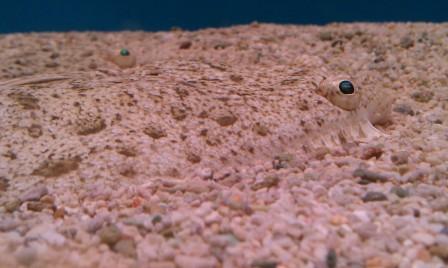
A master of disguise
As promised, I present to you more on the flatfish as master of disguise! This is a photo of the English sole or Pleuronectes vetulus in the flatfish tank at Cabrillo Marine Aquarium. I should clarify that I’m pretty sure this is the English sole after carefully studying all the fish in the tank and looking at the displayed drawings, but because flatfish look very similar I’m not 100% positive on my identification abilities, but pretty sure.
The shape of the English sole is much more long and narrow than other flatfish. And if this fish is viewed vertically, it actually looks like the shape of a Christmas tree, a great tie-in for the holidays!
As you can see from the photo, the English sole is a master of disguise, it blends in perfectly with the sand shaded pebbles on the tank’s bottom. And if you look in the upper left hand corner, you’ll see another eye poking up. That’s a second fish that I didn’t even notice when taking the photo!
According to the book “Probably More Than You Want to Know About the Fishes of the Pacific Coast” by Milton Love, the flatfish has another crazy scientific name. Pleuronectes means “side swimmer,” which makes sense, but the species part of the name vetulus is Latin for old man. What old man? That makes no sense at all. Love remarks that the person who named this fish must have been “hitting the lab alcohol.”
These “old men” can be found from the Gulf of Alaska to Southern California. According to Love, English sole can reach 22.5 inches in length with females growing larger than males. They tend to hang out on the ocean floor closer to shore eating all sorts of fun things including worms, clams, brittle stars and small fish. Large females can lay more than 2 million eggs!
For those celebrating Christmas, may your presents be as plentiful as female English sole eggs and not so well disguised under the tree. Happy holidays everyone!
Fantastic photo, Carolyn!
I second that, great photo! Perhaps the Latin name comes from the fact that a lot of old men eat worms, clams, brittle stars and small fish.